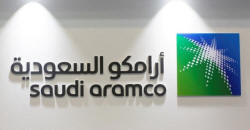|
Trillion-dollar question
looms as Aramco audits oil reserves
 Send a link to a friend
Send a link to a friend
 [March 10, 2017]
By Reem Shamseddine, Rania El Gamal and Alex Lawler [March 10, 2017]
By Reem Shamseddine, Rania El Gamal and Alex Lawler
KHOBAR,
Saudi Arabia/DUBAI (Reuters) - When Saudi Aramco [IPO-ARMO.SE] reveals a
Western audit of its oil reserves, investors will be looking for two
answers: How much oil and how much detail?
Saudi Energy Minister Khalid al-Falih has hinted at a surprise on the
upside on reserve volumes ahead of Aramco's 2018 share listing, but
industry sources say detail on individual deposits – which investors
have long sought - will be thin.
Saudi Arabia's reserves of easily recoverable oil have long been the
world's largest.
But there also have long been questions about the volume and quality of
those reserves. For nearly 30 years - despite rising production, wild
swings in oil prices and improved technology - Riyadh has annually
reported the same number for reserves of 261 billion barrels, according
to BP’s statistical review.
Firms listing in New York are required to have a U.S. Securities and
Exchange Commission audit. Last year, the SEC launched a probe into why
the world's largest listed oil company, ExxonMobil <XOM.N>, reported
virtually unchanged reserves for years despite a plunge in prices.
Exxon revised its reserves down last month.

Having an internationally recognized reserves audit has become a key
task for Aramco as it seeks to become the world's most valuable company
when it lists shares in an initial public offering (IPO) for 5 percent
of the firm's value.
An industry source told Reuters that Aramco aimed to have one of its two
reserves auditors wrap up the review this year, long before the share
listing.
Dallas-based DeGolyer and MacNaughton, and Gaffney, Cline and
Associates, part of Baker Hughes <BHI.N>, are involved in the auditing,
sources have said.
When the reserves are confirmed by the auditors, the results are likely
to be similar to the levels of disclosure by international peers such as
BP <BP.L.> and Royal Dutch/Shell <RDSa.L>, sources familiar with the
process said.
"What Aramco will do in the IPO is try to report in a similar way to
other companies," a senior source with knowledge of the plans said.
Listed majors' reserves reports "vary a bit in detail and some give a
greater breakdown. Aramco probably hasn't decided that yet," the source
said.
Over a decade ago, Shell's stock price collapsed after the company said
it had overstated its reserves by 20 percent. No listed oil major has
seen its stated deposits stay unchanged for the past 30 years.
Aramco declined to comment. "Saudi Aramco does not comment on rumor or
speculation," a company spokesman said. Gaffney, Cline and Associates
also declined to comment, while DeGolyer did not respond to a request
for comment.
A reserves total that is significantly above or below the 261 billion
figure is likely to affect Aramco's potential value. Earlier phases of
the audit have supported Aramco's statements on the total size of
deposits.

[to top of second column] |

Logo of Saudi Aramco is seen at the 20th Middle East Oil & Gas Show
and Conference (MOES 2017) in Manama, Bahrain, March 7, 2017.
REUTERS/Hamad I Mohammed/File Photo

Aramco is showing all its data to the auditors, the sources said, and is
using two firms rather than one in an effort to bolster confidence that
the process is not a rubber-stamping of Aramco figures.
"Our reserves have been partially audited and are bigger than we
actually booked," Falih said this week.
"On every metric, Aramco will surprise analysts on the upside - lowest
cost, highest cash flow, solid reserves that will be certified by
third-party agencies."
WHAT'S IN THE GROUND?
Historically Aramco has provided little detail publicly on its reserves
other than total volume.
Publicly traded oil companies such as BP and Shell with assets
distributed globally give more detail than just a headline figure,
including reserves by geographic location and whether they are developed
or undeveloped.
However, they do not give reserves by individual field - and for Aramco
that is precisely what investors want, because its oil is concentrated
in one country, Saudi Arabia.
Sadad al-Husseini, a former Aramco senior executive and now energy
consultant, said Aramco has extensive details on its reserves in every
field but it was not common practice for national oil companies to
identify their deposits on that basis.
"What it might do initially is give a corporate summary and break it
down by crude grade with more data to follow," he said.
Aramco's precise level of disclosure has yet to be decided, the source
familiar with the plans said. He noted that Western majors do not list
reserves by field.

"There is no way Aramco will be giving field-by-field detailed
reserves," another industry source familiar with the plans said, adding
that the firm considers reserves decline rates and field maturity as
sensitive, non-public data.
The question of how much oil is left at the biggest Saudi field, Ghawar,
has long intrigued market watchers.
"What they need to offer is a package of assets with value-chain,
operating and financial detail comparable to that made available by
integrated oil companies," said Jason Kenney, head of European oil and
gas research at Santander.
"I doubt you're going to get a full breakdown of the 261 billion barrels
- but maybe the IPO is not about a full upstream offering either. To
attract the investors, you’ve got to offer the same level of
transparency as alternative investments."
(Reporting by Reem Shamseddine in Khobar, Rania El Gamal in Dubai and
Alex Lawler in London; Editing by Dmitry Zhdannikov and Dale Hudson)
[© 2017 Thomson Reuters. All rights
reserved.] Copyright 2017 Reuters. All rights reserved. This material may not be published,
broadcast, rewritten or redistributed. |